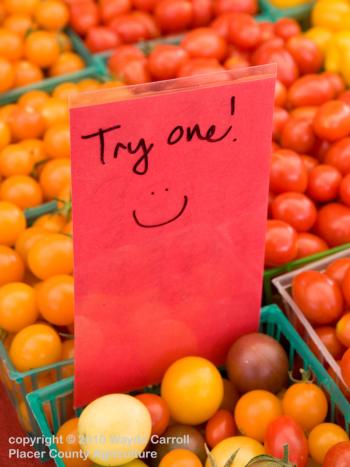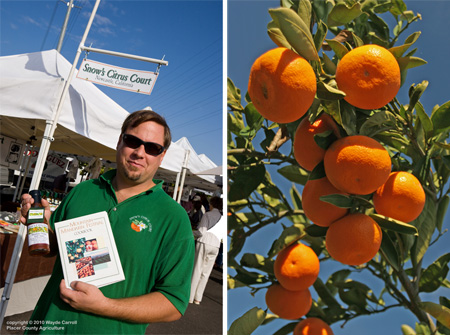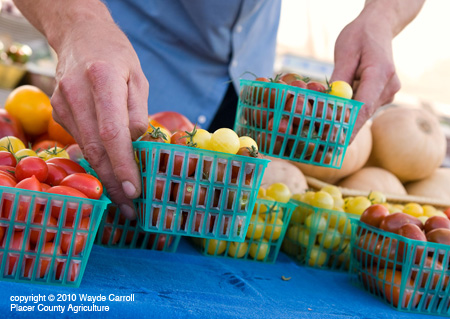Marketing

- What should I grow? How much of it should I grow and harvest at a given time?
- Who is my ideal customer? Where can I most effectively connect with that customer base?
- How will I appeal to these customers and entice them to buy my products?
- How can I estimate how much they will buy?
- How can I develop the flexibility to change my marketing strategy if my current plan isn't giving me the results I desire?
Remember, answering these questions will help you work on other parts of your operation – your farm business plan, production schedule, assessment of your financial needs – so you're actually multitasking as you peruse these pages! Looking for something specific? Jump to a section with these links:
- Marketing Basics: resources for getting started
- Market Analysis: understanding the markets available to you, the needs of those markets, and how (and if) those needs are being met
- Assessing and Managing Marketing Risk: understanding your risks thoroughly, in order both to reduce them and to deal with them when they arise
- Other Marketing Options: using multimedia, social media, and more
- Grower Stories: creating a compelling story about your farm
Looking for farmers' markets, marketing associations, programs, and information on other ag marketing opportunities? Visit our Farm Marketing Resources page.
Marketing Basics
UCCE Placer/Nevada and UC Resources
- OSA 091: Internet Information Resources for New Growers
- OSA 093: Getting Started as a Direct Market Grower
- OSA 098: Local Market Wishlist (2012)
- How to get started as a Farmers' Market vendor
- Determining Marketing Costs and Returns in Alternative Marketing Channels (UC Davis Small Farm Program)
Other Resources
- To Market, To Market (Rutgers Cooperative Extension)
- Direct Marketing (ATTRA)
- Farmers Markets: Marketing and Business Guide (ATTRA)
- Growing for Market: News, Advice and Resources for Market Farmers (website)
- Growing for Market: Special Report on Selling at Farmer's Markets
- Marketing Strategies for Farmers and Ranchers (SARE)

Assessing and Managing Marketing Risk
Marketing risk is one of the five types of agricultural risk you need to assess, plan for, and manage. You must understand your risks thoroughly in order both to reduce them and to make contingency plans to deal with them when they arise.
Sources of marketing risk include:
Sources of marketing risk include:
- price risk due to increases in supply, changed demand, market trends, or improper pricing of products;
- loss of market access due to the relocation or closing of an existing market or processing plant or lack of understanding of the requirements of various market options;
- loss of marketing power due to lack of knowledge about potential marketing opportunities and options;
- improper or lax recordkeeping resulting in having too much or not enough product week-over-week at a given market.
Ways of assessing and managing marketing risk include:
- Creating a marketing plan, a constantly evolving document that relates directly to your farm business plan
- Maintaining your knowledge of markets for your products via regular market analysis and customer research
- Pricing correctly for your markets and your efforts
- Effective record-keeping
- Exploring alternative marketing strategies, alternative marketing organizations, and value-added ventures
Some Marketing Risk Resources:
Click here for more marketing risk information.
Source: USDA Risk Management Agency. "Introduction to Risk Management: Understanding Agricultural Risks." Revised December 1997
- OSA 95C Farming in Challenging Economic Times
- UC Davis Small Farm Center Marketing - General Information
- UC Davis Small Farm Center: Developing Your Marketing Plan
- ATTRA - Direct Marketing
- Cornell - Smart Marketing - Managing Marketing Risks
- OSU Farm and Ranch Survival Kit - Marketing
- Iowa State U - Determining Prices for CSA Share Boxes
- Penn State Extension - Record Keeping as a Form of Risk Management
- University of Florida IFAS Extension - Value-Added Agriculture: Is It Right for Me?
Click here for more marketing risk information.
Source: USDA Risk Management Agency. "Introduction to Risk Management: Understanding Agricultural Risks." Revised December 1997
Market Analysis
Market analysis clarifies the markets available to you, the needs of those markets, and how (and if) those needs are being met. This information will help you appeal to customers and satisfy market needs.
Customer research is a significant part of market analysis. It helps you understand the demographics, values, and motivations of the customer base you wish to serve.
These tools will help you hone your product and your marketing tactics and reduce the time you spend on ineffective strategies:
These tools will help you hone your product and your marketing tactics and reduce the time you spend on ineffective strategies:
- A Marketing Primer for Start-up Business - Agricultural Marketing Resource Center
- ATTRA - Adding Value to Farm Products: An Overview
- ATTRA - Community Supported Agriculture
- ATTRA - Direct Marketing
- ATTRA - Entertainment Farming and Agri-Tourism
- ATTRA - Farmers' Markets
- ATTRA - Market Gardening: A Start-up Guide
- ATTRA - Selling to Restaurants
- Cal Poly San Luis Obispo - Developing Your Market Plan
- Cornell - Knowing Your Market: The Most Challening Part of a Business Plan
- Cornell - Travel the Road to Success with a Marketing Plan
- Iowa State U - Determining Prices for CSA Share Boxes
- Purdue Extension - Marketing's Four P's: First Steps for New Entrepreneurs
- South Dakota State University - Market Plan

Grower Stories
Creating a compelling story about your operation, including your mission, vision, goals, values, products, farm landscape, and/or a bit of biographical information, can improve the marketability of your products and the appeal of your business to existing and potential customers.
The following are examples from local growers who make use of good grower stories:
- Boorinakis Harper Ranch, Auburn
- Flying Mule Farm, Auburn
- Nitta Ranch, Loomis
- Riverhill Farm, Nevada City
- The James Ranch, Penn Valley
Other Marketing Options

An example of grower use of these tools is Dinner Bell Farm in Chicago Park. In addition to a website, they use YouTube videos, Twitter, Facebook, and a Flickr photo gallery.


